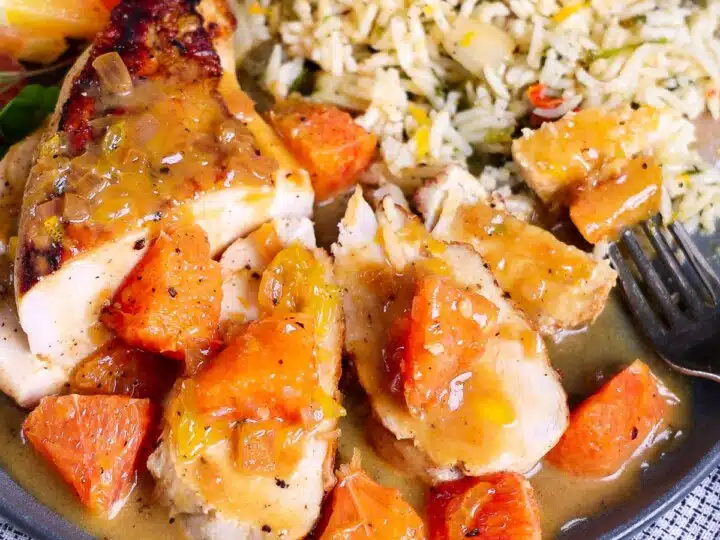An 8- to 12-inch chef's knife (also chefs knife) is the most often used knife in the kitchen and the perfect tool for most chopping needs. Here's what you need to know when buying and using.

Choosing the right kitchen knife is essential for any home cook or professional chef. A quality knife can significantly enhance your cutting abilities and elevate the overall quality of your cooking.
Once you have your knife, be sure to maintain it with regular sharpening and
honing. A sharp knife is safer than a dull one, having less tendency to slip or slide rather than to cut as it should. It will also give you better and more beautiful results; a dull knife can tear and damage foods rather than chop or slice.
Jump to:
Parts of a Chef's Knife
The handle - An excellent handle should feel comfortable and secure when held. It should not require excessive effort to grip, nor should it become slippery when wet. Sufficient clearance underneath the handle is essential to avoid banging your knuckles while chopping. While some handles feature indentations to enhance grip, these may not suit everyone as they can enforce an unnatural grip and create difficulties in holding the knife at a comfortable angle.
The bolster - Also referred to as the collar, shoulder, or shank, the bolster is the thick metal portion where the blade and handle converge. It provides added strength and stability to the knife while acting as a finger guard for your gripping hand. While some knives feature partial bolsters, certain types like Japanese knives may have no bolster at all. The advantage of no or partial bolster is that the entire length of the blade can be sharpened, extending through to the heel.
The butt - The rear end of the knife is known as the butt. In knives with a full tang and riveted handle, the tang is visible between the two handle pieces at the butt.
The heel - Unless it is a Japanese knife (as described below), the heel represents the widest and thickest part of the edge, offering substantial weight. It is designed for tasks requiring force, such as chopping through poultry tendons or the tough peel of winter squash. Be cautious of knives that produce a "thunk" at the heel when rocked; it should not abruptly halt the rocking motion, nor should the blade be so curved that it tends to kick backward.
The edge - A high-quality chef's knife should come sharp right out of the box. Assess sharpness by attempting to slice through a sheet of paper. A properly sharpened knife will effortlessly make a clean cut through the paper. Also, observe the blade's curvature, which should exhibit a gentle arc from the tip to the heel.

The tang - The tang is the metal that extends into the handle, is integral to a knife's longevity, balance, and effectiveness. Knives may feature a full tang (metal running the entire handle length) or partial tang (metal running into part of the handle).
Full-tang knives boast durability, strength, and balance. Their solid construction minimizes the chances of blade breakage or handle detachment, ensuring a reliable tool. With evenly distributed weight, they offer improved balance, enhancing control and precision in cutting tasks.
Partial tang knives are prone to structural weaknesses, particularly under heavy use or lateral forces. The shorter tang increases the risk of blade wobbling or detachment, compromising functionality and safety.
The spine - This refers to the upper portion of the blade, typically with a squared edge. Pay attention to whether the edges feel polished or rough, as rough edges may potentially irritate your gripping hand. Additionally, the spine should taper towards the tip; a thick tip can be cumbersome to work with.
The tip - The pointed end of the knife blade is known as the tip, often used for intricate cuts or food carving. It encompasses the point and is particularly useful for precise tasks.
How to Hold a Chef's Knife

For optimal control, adjust your grip to hold both the handle and blade of the knife. (Holding only the handle may make the blade difficult to manage.) Place the handle in your palm, with your index finger wrapping over the bolster and resting on the side of the blade. Your thumb should rest on the opposite side, applying pressure with your thumb and forefinger to stabilize the blade. The cutting force originates from the palm of your hand, while your thumb and forefinger maintain stability and guide the blade during the cut.
Hand Position: When slicing or dicing, use your other hand to secure the ingredient and guide the knife's motion for desired thickness. Always curl the fingertips of this hand inward to keep them away from the sharp edge of the knife. For larger knives like a chef's knife, the flat surface of your fingers will guide the blade, ensuring each slice is made with steady precision.
How to Buy a Chef's Knife
There is no one knife to fit all, a chef's knife is a personal choice. The best way to choose a knife is to pick it up and hold it your hand. It should feel balanced, with the weight of the blade equal to that of the handle. Almost more important, it should feel right in your hand: the handle, the size of the blade, and the weight of the knife. The knife should feel like an extension of your hand.
About Japanese Knives

A Japanese-style knife tends to be lighter and have a thinner blade, but it's made of a harder steel that sometimes is layered. The knives are highly maneuverable and extremely sharp. The edge is usually not a curved as western-style knives, so the knives don't rock as smoothly. Shun Knives is one of my favorite Japanese knife brands.
Recipes to try
Get a Free e-book!

Let's connect!
Be sure to FOLLOW US on FACEBOOK, INSTAGRAM, TIKTOK and PINTEREST Many thanks!








Leave a Comment